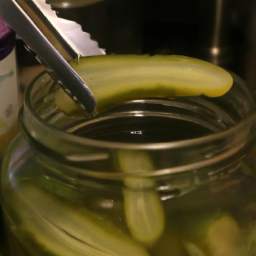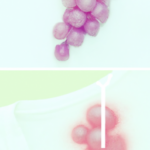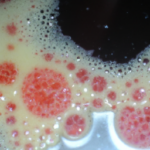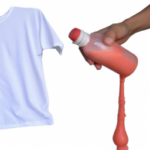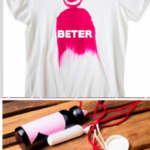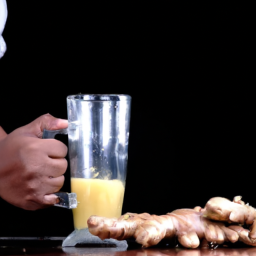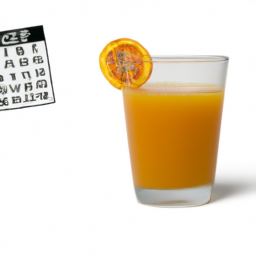I know the feeling too well – enjoying a tasty glass of fruit juice, only to accidentally spill it all over my clothes. Those bright, colorful stains may seem tough to tackle, but fear not! With the correct knowledge and quick action, getting rid of fruit juice stains from clothing can be quite simple.
The key to successfully removing fruit juice stains is to act fast. The longer the stain sits, the harder it will be to remove. But don’t panic – with a few simple steps, you can effectively remove the stain and restore your clothes to their former glory.
In this article, I’ll guide you through the process of:
- identifying the stain type
- blotting the stain
- rinsing with cold water
- applying stain remover
- using natural remedies
- washing the clothes
- checking for residual stains
- preventing future stains.
So, let’s get started and say goodbye to those pesky fruit juice stains!
Key Takeaways
- Acting quickly is crucial to prevent the fruit juice stain from setting.
- Different types of fruit juice may require specific removal methods.
- Avoid rubbing or spreading the stain to prevent further damage to the fabric.
- Pre-treating clothes with detergent and washing them with an enzyme-containing laundry detergent is essential for maximum stain removal.
Identify the Stain Type
If you’ve got a fruit juice stain on your clothes, the first step is to identify the type of stain so you can tackle it with the right method.
There are different types of fruit juices, and each can leave a unique stain on your clothes. For instance, citrus fruits like oranges and lemons contain natural acids that can cause discoloration on fabrics. On the other hand, berries like strawberries and blueberries have pigments that can be challenging to remove.
To determine the type of fruit juice stain you’re dealing with, you need to examine the color and texture of the stain. Try to remember what type of fruit juice you spilled on your clothes, and look for any visible signs of the stain on the fabric.
Once you’ve identified the stain type, you can explore different stain removal techniques to get rid of it. If the stain is particularly stubborn or delicate, you may need to take your clothes to a professional dry cleaning service.
Now that you’ve identified the type of fruit juice stain on your clothes, it’s crucial to act fast to prevent it from setting on the fabric.
Act Fast
When it comes to getting fruit juice stains out of clothes, acting fast is crucial. The longer you wait, the more difficult it becomes to remove the stain completely.
As soon as the spill happens, take immediate action to prevent the stain from setting.
Importance of immediate action
Don’t hesitate to act quickly when fruit juice stains your clothes – the importance of quick action cannot be overstated. Waiting too long before treating the stain can have long term consequences, making it nearly impossible to remove.
To illustrate the importance of acting fast, consider the following:
- Fruit juice stains are notorious for quickly setting into fabrics, so time is of the essence.
- The longer you wait to treat the stain, the more time the juice has to penetrate and seep into the fibers of your clothing.
- Once the stain sets, it may require professional cleaning or even replacement of the garment.
- The acidity of fruit juice can also cause discoloration and damage to fabrics, making it even more difficult to remove the stain.
Therefore, it’s crucial to act quickly when dealing with a fruit juice stain on your clothes. By doing so, you increase your chances of successfully removing the stain and avoiding potential long-term damage.
To prevent the stain from setting, the next step is to focus on preventing the juice from spreading and penetrating deeper into the fibers of your clothing.
Preventing the stain from setting
You’d think that letting a fruit juice stain sit on your clothes would be a great way to infuse them with a lovely fruity scent, but unfortunately, it’s not.
In fact, the longer you let the stain sit, the harder it will be to remove. That’s why it’s crucial to take preventive measures and respond quickly when the stain occurs.
To prevent the stain from setting, you should immediately remove any excess juice from the clothing using a spoon or a dull knife. Be careful not to spread the stain further by rubbing it into the fabric.
After removing the excess juice, rinse the fabric under cold running water as soon as possible. The cold water will help to dilute the stain and prevent it from setting in the fibers of the fabric. Remember to avoid using hot water or a dryer, as the heat can set the stain permanently.
By acting quickly and taking preventive measures, you can increase your chances of removing the fruit juice stain successfully. Now that you have prevented the stain from setting, let’s move on to the next step of blotting the stain.
Blot the Stain
So, the next step after acting fast when dealing with fruit juice stains on clothes is to blot the stain.
Blotting is key to absorbing excess liquid from the stain and preventing it from spreading or rubbing deeper into the fabric.
As someone who’s dealt with fruit juice stains before, I know that avoiding rubbing or spreading the stain is crucial to ensure that it doesn’t become even more difficult to remove.
Absorbing excess liquid
To effectively absorb excess fruit juice from your clothes, simply grab a clean towel or cloth and press it onto the stain. Here are some tips to make sure you’re doing it right:
-
Use absorbent materials such as paper towels, clean cloths, or napkins to soak up the excess juice.
-
Press the cloth onto the stain firmly to absorb as much juice as possible. Avoid rubbing the stain, as this can spread the juice and make the stain worse.
-
Keep pressing the cloth onto the stain until no more juice comes out. If the cloth becomes saturated, use a fresh one.
-
Repeat the process with a new cloth until the stain is no longer visible.
Once you’ve absorbed as much juice as possible, it’s important to move on to the next step to avoid rubbing or spreading the stain.
Avoiding rubbing or spreading the stain
After absorbing excess liquid from the fruit juice spill on my shirt, I knew that my next step was to avoid rubbing or spreading the stain.
Stain prevention is critical to ensure that the fruit juice doesn’t seep deeper into the fabric and become even harder to remove. Rubbing or spreading the stain could also cause the dye to transfer onto other parts of the garment, further complicating the cleaning process.
To avoid rubbing or spreading the stain, I made sure to select the right fabric for cleaning. Some fabrics, such as silk or wool, are more delicate and require special care when removing stains.
To prevent damage to the fabric, I used a gentle blotting motion with a clean cloth to dab the stain. This helped to lift the stain without pushing it deeper into the fibers of the fabric. By taking these measures, I was able to effectively contain the stain and prepare my shirt for the next step in the cleaning process – rinsing with cold water.
Rinse with Cold Water
By washing the stain with cold water, you can stop it from sinking its roots deep into the fabric like a stubborn weed.
There are many benefits to using cold water for stain removal, such as preventing the stain from setting in and making it easier to remove.
When rinsing with cold water, it’s important to avoid common mistakes like using hot water or rubbing the stain vigorously. Hot water can actually cause the stain to set in, while rubbing can spread the stain and make it harder to remove.
To rinse the stain with cold water, start by running the fabric under a cold tap. Make sure the water is cold and not lukewarm, as this can still cause the stain to set in.
Hold the fabric under the running water and gently rub the stain with your fingers. If the stain is particularly stubborn, you can also try soaking the fabric in cold water for a few minutes before rinsing it out.
Once you’ve rinsed the fabric thoroughly, you can move on to the next step of applying stain remover.
Apply Stain Remover
Now it’s time to attack that stubborn stain head-on with a powerful stain remover that’ll break down the molecules and lift the discoloration from your fabric, leaving it looking fresh and clean.
When it comes to fruit juice stains, there are several effective stain remover options out there. Here are some alternatives to consider:
- Hydrogen peroxide: This DIY stain remover is effective on fruit juice stains and is also eco-friendly.
- White vinegar: This natural option can be used to pre-treat the stain before washing and is also a great eco-friendly alternative.
- Baking soda: This household staple can work wonders on fresh fruit juice stains, especially when mixed with water to create a paste.
- Lemon juice: The natural acid in lemon juice can help break down the stain, but be cautious as it may also bleach the fabric.
- Commercial stain remover: There are a variety of stain removers available on the market, but be sure to choose one that’s safe for your fabric.
While these alternatives are effective, it’s important to note that the effectiveness of DIY stain removers may vary depending on the specific fabric and type of stain. Pre-testing on a small, inconspicuous area of the fabric is always recommended.
To ensure maximum stain removal, pre-treating with detergent is the next step.
Pre-treat with Detergent
First, you’ll want to grab your favorite laundry detergent and pre-treat the stain to ensure maximum removal. Effective pre-treating techniques involve applying a small amount of detergent directly onto the stain and rubbing it in gently. Allow the detergent to sit for at least 10 minutes before washing the garment as usual. For tougher stains, you may want to let the pre-treatment sit for up to an hour before washing.
When it comes to choosing the best detergent for pre-treating fruit juice stains, look for one that contains enzymes or is specifically formulated for tough stains. Enzymes work by breaking down the proteins in the stain, making it easier to remove. Some popular detergents for pre-treating stains include Tide, Persil, and OxiClean.
Once you’ve pre-treated the stain, you can move on to using natural remedies to further remove any remaining juice stains.
Use Natural Remedies
Using natural remedies to remove fruit juice stains can be an effective and eco-friendly alternative to harsh chemicals. There are many natural alternatives and DIY solutions that can effectively lift the stain from your clothes. Here are some options to consider:
| Natural Remedy | How to Use |
|---|---|
| White Vinegar | Mix equal parts white vinegar and water. Soak the stained area for 30 minutes before washing. |
| Baking Soda | Create a paste using 4 tablespoons of baking soda and 1/4 cup of water. Spread the paste onto the stain and let it sit for 15-20 minutes before washing. |
| Lemon Juice | Saturate the stain with lemon juice and let it sit in the sun for a few hours. Wash as usual. |
These natural remedies can be just as effective as commercial stain removers, and they are much gentler on both your clothes and the environment. Once you have tried one of these remedies, it’s time to move on to the next step: washing the clothes.
Wash the Clothes
To effectively remove the fruit juice stain, you’ll need to wash your clothes with a laundry detergent that contains enzymes. Choosing the right detergent is crucial in getting rid of the stain. Look for a detergent that contains protease, amylase, and lipase enzymes as they break down protein, starch, and fat respectively.
These enzymes will help break down the fruit juice stain, making it easier to wash away. When washing clothes, the temperature of the water is important. Use hot water if the fabric can handle it, as it helps to break down the stain. However, if the fabric is delicate, use cold water to avoid damaging it.
Cotton and polyester are the best fabrics for fruit juice stains as they are durable and can withstand hot water. For delicate fabrics such as silk, wool, or linen, consider alternative washing methods such as hand washing with cold water or using a stain remover specifically designed for delicate fabrics.
As you finish washing your clothes, it’s crucial to check for residual stains. Residual stains can be difficult to remove once the clothes have been dried. In the next section, we’ll discuss how to check and remove any remaining stains.
Check for Residual Stains
Don’t forget to double-check your clothes for any leftover stains before drying them to ensure that your efforts in removing the fruit juice stain were successful. Even if you think you’ve removed the stain completely, it’s always a good idea to inspect the clothing item thoroughly before moving on. Here are some tips and tricks to help you with the inspection process.
To check for residual stains, you’ll need a clean white cloth and some water. Simply dampen the cloth with water and gently rub the stained area. Check the cloth for any discoloration or transfer of color from the clothing item. If the cloth shows any signs of the fruit juice stain, repeat the stain removal process until it’s completely gone. It’s important to avoid some common mistakes when removing fruit juice stains, such as using hot water or putting the clothing item in the dryer before the stain is fully removed. By following these tips, you can ensure that your clothing item is free of any fruit juice stains.
Now that you’ve successfully removed the fruit juice stain from your clothes, it’s important to prevent future stains.
Preventing Future Stains
So, to avoid future fruit juice stains, I always follow a few simple tips. Firstly, I try to be careful when drinking or handling any kind of fruit juice. I make sure to use a straw or drink slowly and keep the glass away from my clothes.
Secondly, I pre-treat my clothes before wearing them. This helps to create a barrier between the fabric and any potential stains, making it easier to remove them later on.
Lastly, I always wash my clothes as soon as possible after any spills or stains to prevent them from setting in. These simple steps have saved me from countless fruit juice disasters!
Tips for avoiding fruit juice stains
You can keep your clothes stain-free by being mindful of the way you handle fruit juice. For example, pour it slowly and carefully or use a straw to drink it. Here are some tips for avoiding fruit juice stains:
-
Choose stain-resistant fabrics: When shopping for clothes, consider fabrics that are less likely to stain, such as polyester, nylon, or spandex blends. These fabrics are easier to clean and may not absorb the juice as quickly as cotton or linen.
-
Use a napkin or paper towel: Keep a napkin or paper towel handy when drinking fruit juice. If you accidentally spill some, quickly blot the stain with the napkin or paper towel to prevent it from setting.
-
Wash your hands: Before handling fruit juice, make sure your hands are clean. This will help prevent any dirt or oils on your hands from transferring onto your clothes and making the stain worse.
-
Store stained clothes separately: If you do end up with a fruit juice stain, don’t mix the stained clothes with your clean clothes. This will prevent the stain from spreading to other items in your wardrobe.
By following these tips, you can reduce the chances of getting fruit juice stains on your clothes. Once you’ve learned how to prevent stains, the next step is to learn how to pre-treat clothes before wearing them.
Pre-treating clothes before wearing them
Now that we have gone through tips for avoiding fruit juice stains, let’s talk about pre-treating clothes before wearing them. Stain prevention is key, especially when it comes to fruit juice stains. Knowing how to properly pre-treat your clothes can help prevent stains from setting in and make it easier to remove them later on.
One of the most important factors to consider when pre-treating clothes is fabric selection. Different fabrics require different pre-treatment methods, and some are more prone to stains than others. For example, cotton is a common fabric that is easy to wash and pre-treat, while silk requires more delicate handling. To help you better understand how to pre-treat different fabrics, take a look at the table below:
| Fabric Type | Pre-Treatment Method |
|---|---|
| Cotton | Soak in cold water with detergent before washing |
| Wool | Spot-treat with a wool-safe stain remover |
| Silk | Blot with a white cloth and apply a silk-safe stain remover |
| Polyester | Soak in warm water with detergent before washing |
| Rayon | Spot-treat with a fabric-safe stain remover |
By taking the time to properly pre-treat your clothes before wearing them, you can help prevent fruit juice stains from setting in. Remember to consider the type of fabric you are working with and use a pre-treatment method that is appropriate for that fabric. With a little bit of knowledge and care, you can keep your clothes looking great and stain-free.
Frequently Asked Questions
What should I do if I don’t have any stain remover or detergent at home?
When I don’t have stain remover or detergent at home, I turn to alternative stain removal methods using household items. For example, I mix baking soda and vinegar to create a paste and apply it to the stain before washing.
Can I use warm or hot water to rinse the stain instead of cold water?
Using warm water for fruit juice stains is not recommended as it can set the stain. Alternative stain removal methods include using vinegar, baking soda, or lemon juice. Always test a small area first and blot, don’t rub.
How long should I let the stain remover sit on the stain before washing the clothes?
I always let stain remover sit on the fabric for at least 10 minutes before washing it. This gives the product enough time to work its magic and increase its effectiveness. Pre treating techniques are crucial for removing tough stains, so don’t rush the process.
Are there any specific types of fruit juice stains that require different treatment methods?
Some types of fruit juices, such as pomegranate or grape, leave stubborn stains that require different treatment methods. To prevent stains, try to blot immediately and pre-treat with vinegar or lemon juice before washing.
Can I put the stained clothes in the dryer before checking for residual stains?
I wouldn’t recommend putting stained clothes in the dryer before checking for residual stains. It can result in re-staining and make the stain more difficult to remove. Proper drying technique involves air-drying and checking for any remaining stains before washing.
Conclusion
Well, that was quite the sticky situation! But don’t worry, with these tips, getting fruit juice out of clothes has never been easier.
Remember to identify the type of stain and act fast, as time is of the essence when it comes to removing stubborn stains. Blotting the stain and rinsing with cold water are also crucial steps in the process.
If the stain persists, don’t fret. There are plenty of natural remedies and stain removers that can help lift even the toughest of stains. And once you’ve successfully removed the stain, always make sure to thoroughly wash the clothes and check for any residual stains.
Of course, prevention is always the best course of action. Consider wearing an apron or taking extra care when eating juicy fruits to avoid any future clothing mishaps. With these tips in mind, you can rest easy knowing that you can tackle any fruit juice stain that comes your way.
Ilana has been a vegan for over 10 years. She originally made the switch for health reasons, but soon found herself becoming more and more passionate about the ethical and environmental implications of a vegan lifestyle. Ilana is the author of The Graceful Kitchen, a blog all about veganism. She loves to cook up delicious and nutritious vegan meals, and share her recipes with others who are interested in leading a cruelty-free life. Ilana is also a strong advocate for using whole foods as the foundation of a healthy diet, and believes that going vegan is one of the best ways to achieve this.

